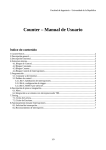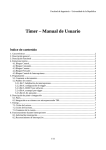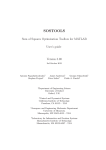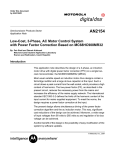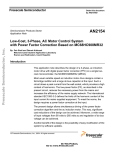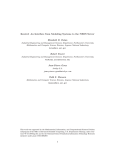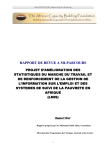Download ROBUST LMI PARSER: A COMPUTATIONAL PACKAGE TO
Transcript
Anais do XIX Congresso Brasileiro de Automática, CBA 2012. ROBUST LMI PARSER: A COMPUTATIONAL PACKAGE TO CONSTRUCT LMI CONDITIONS FOR UNCERTAIN SYSTEMS Cristiano M. Agulhari∗, Ricardo C. L. F. Oliveira∗, Pedro L. D. Peres∗ ∗ School of Electrical and Computer Engineering, University of Campinas – UNICAMP, 13083-852, Campinas, SP, Brazil. Emails: [email protected], [email protected], [email protected] Abstract— A computational package to construct linear matrix inequality (LMI) finite-dimensional conditions from parameter-dependent infinite-dimensional LMIs whose parameters lie in the unit simplex is proposed. The package, named Robust LMI Parser, is developed for Matlab and works jointly with YALMIP, returning the entire set of LMIs through simple commands that describe the structure of the matrices involved and the robust LMI conditions to be programmed. The performance of the parser is compared, through numerical computations, with Pólya filter available in the robust optimization framework of YALMIP. Keywords— Parser, LMIs, computational package, uncertain systems Resumo— Neste artigo é apresentado um pacote computacional para a interpretação e construção de condições na forma de desigualdades matriciais lineares (Linear Matrix Inequalities - LMIs) de dimensão finita a partir de LMIs de dimensão infinita dependentes de parâmetros pertencentes ao simplex unitário. O pacote, denominado Robust LMI Parser, é desenvolvido para o Matlab, funciona em conjunto com o YALMIP e é capaz de construir todo o conjunto de LMIs desejado a partir de simples comandos que descrevem a estrutura das matrizes envolvidas e as condições LMIs robustas a serem programadas. O desempenho do interpretador é comparado, por meio de experimentos numéricos, com o filtro de Pólya disponível no pacote Robust Optimization do YALMIP. Palavras-chave— 1 Interpretador, LMIs, pacote computacional, sistemas incertos Introduction In the last decades, problems formulated in terms of Linear Matrix Inequality (LMI) conditions and solved by Semidefinite Programming (SPD) techniques became more and more common in several fields related to engineering and applied mathematics. Specifically in control theory, the growing usage of such tools have led to important results on the analysis of systems stability, synthesis of stabilizing robust controllers for uncertain systems and synthesis of optimal control models, just to name a few (Boyd et al., 1994; Chesi et al., 2009). Accompanying the growth of the usage of LMI conditions, a large number of solvers based on interior point methods were developed, as well as interfaces for parsing the LMIs, most of them free and easily accessible. Thanks to such remarkable advance in the computational tools to define, manipulate and solve LMIs, in many cases one can say that if a problem can be cast as a set of LMIs, then it can be considered as solved (Boyd et al., 1994). Unfortunately, this is not completely true for large scale systems, since LMI solvers are limited to a few thousands of variables and LMI rows, but progresses are being made. Usually, LMIs are solved in two steps: first, an interface for parsing the conditions is used, for example the YALMIP parser (Löfberg, 2004) or the LMI Control Toolbox from Matlab (Gahinet et al., 1995); and an LMI solver is then applied to find a solution (if any), for example SeDuMi ISBN: 978-85-8001-069-5 (Sturm, 1999) or SDPT3 (Toh et al., 1999). Some auxiliary toolboxes may also be used in addition to the parser and the solver, for example the SOSTOOLS (Prajna et al., 2004), which is used to transform a sum of squares problem into a SDP formulation, and Gloptipoly (Henrion and Lasserre, 2003), used to handle optimization problems over polynomials. Consider, for instance, the problem of analyzing the stability of a discrete-time linear system given by x(k + 1) = Ax(k), (1) with x(k) ∈ Rn being the state vector of the system and A ∈ Rn×n being the dynamic matrix. Using Lyapunov stability theory, such system is stable if and only if there exists a symmetric matrix P ∈ Rn×n such that the LMI P A′ P >0 (2) PA P holds. Such LMI can be easily programmed and solved using, respectively, any LMI parser and solver available. Consider now that system (1) is affected by uncertainties, i.e., the system matrix is parameterdependent and denoted by A(α). The robust stability of such system can be assessed by rewriting the LMI condition (2) as P (α) A(α)′ P (α) >0 (3) P (α)A(α) P (α) but, in this case, (3) must hold for all admissible α. In order to transform the parameter-dependent 2298 Anais do XIX Congresso Brasileiro de Automática, CBA 2012. LMI into a finite set of standard LMIs, some information about A(α) must be added, as well as some structure must be imposed to the unknown variable P (α). For instance, consider that A(α) and P (α) have a polytopic structure A(α) = N X αi Ai , P (α) = N X αi Pi , α ∈ ∆N , i=1 i=1 (4) being Ai and Pi the vertices of the respective polytopes, N the number of vertices and ∆N the set known as unit simplex, given by N X αi = 1 , αi ≥ 0 , ∆N = α ∈ RN : i=1 i = 1, . . . , N . (5) Using the chosen structure for A(α) and P (α), given by (4), to the robust stability condition expressed in the parameter-dependent LMI (3), and multipliying the entries on the main diagonal by PN α , one gets the homogeneous polynomial i i=1 matrix inequality of degree 2 on α shown in (6) (top of next page). A sufficient (but not necessary) way to guarantee that (3) holds is to impose that all the matrix coefficients of the monomials are positive definite. This has been done, for instance, in (Ramos and Peres, 2001) (discrete-time systems) and (Ramos and Peres, 2002) (continuoustime systems). A less conservative set of conditions may be obtained by modeling the variable P (α) in (6) as a homogeneous polynomial with generic integer degree g > 1 and then imposing the positivity of all matrix coefficients (Oliveira and Peres, 2006; Bliman et al., 2006). Programming these LMIs requires an a priori knowledge on the formation law of the monomials, which depends on the number N of uncertain parameters and on the degree of the polynomial variable P (α). In (Oliveira and Peres, 2007), a systematic way to deal with such cases has been developed, but in the context of robust LMIs presenting at most products between two parameter-dependent matrices. When the LMIs to be solved are more complex and have products involving three or more parameter-dependent matrices, the rules to compose the monomials become more complicated. Moreover, each new case demands the manipulation of different polynomials. Such task, as well as programming the resulting LMIs, is tedious, timedemanding and can be a source of programming errors. Such problems can be partially mitigated by the Pólya filter provided in the robust optimization framework of YALMIP (Löfberg, 2012): affine parameter-dependent LMIs can be easily programmed using YALMIP and even Pólya relaxations can be automatically performed, but the ISBN: 978-85-8001-069-5 definition of variables that are modeled as homogeneous polynomials of degree g > 1 is not straightforward. The computational package presented in this paper, called Robust LMI Parser1 (ROLMIP), was developed to deal specifically with operations concerning parameter-dependent variables whose parameters are contained in the unit simplex. The parser is developed for Matlab and works jointly with YALMIP, returning the entire set of LMIs through a few simple commands that describe the structure of the known matrices and variables involved in the parameterdependent LMIs to be investigated. Since the parser is a specific purpose application, it is considerably faster than the Pólya filter from YALMIP. The paper is organized as follows. Section 2 presents the assumptions considered in the parser and the notation used throughout the paper. The details on the syntaxes of the commands are presented in Sections 3, 4, 5 and 6. A comparison between the parser and YALMIP is performed through some illustrative examples in Section 7, and Section 8 concludes the paper. 2 Preliminaries The parser, named ROLMIP, currently considers the following assumptions: • All the matrices are described as homogeneous polynomials on the uncertain parameter vector α; • The vector of parameters α belong to the unit simplex ∆N , defined in (5). Several examples illustrating the usage of the commands are presented throughout the paper. Such commands are displayed using the Typewriter font and start with ». 3 Defining the polynomial structure The first step for using ROLMIP is to define all the variables and constants used in the LMIs through the procedure poly_struct, which has basically three possible syntaxes. If the coefficients of the monomials are already defined, the related polynomial structure is obtained by [poly] = poly_struct(M,label,vertices,degree) . The output poly (whose detailed description can be found on the ROLMIP user manual) is a structured variable that fully describes the polynomial variable. All the terms used in the LMIs must be defined through the poly_struct procedure, even the scalars and the precisely known matrices. Since the variables defined by poly_struct 1 Available at http://www.dt.fee.unicamp.br/ ~agulhari/softwares/robust_lmi_parser.zip 2299 Anais do XIX Congresso Brasileiro de Automática, CBA 2012. P (α) P (α)A(α) X N Pi A(α)′ P (α) 2 αi = Pi Ai P (α) i=1 NX −1 X N Pi + Pj A′i Pi αi αj + Pi Pi Aj + Pj Ai i=1 j=i+1 A′i Pj + A′j Pi > 0. Pi + Pj (6) are automatically stored by ROLMIP, the output poly is not mandatory. The variable M corresponds to the coefficients of the monomials of the homogeneous polynomial to be defined. If the polynomial has a number r of monomials, all the r components must be given in M. For example, consider that matrix A(α) has the following structure A(α) = α1 A1 +α2 A2 , α1 +α2 = 1, α1 ≥ 0, α2 ≥ 0 (7) i.e., A(α) is characterized by a polytope of N = 2 vertices and is modeled as a homogeneous polynomial of degree g = 1. There are two ways of inputting the coefficients A1 and A2 using the variable M: • Concatenating the matrices A1 and A2 : » M = [A1 A2]; • Using M as a cell array: The number r of monomials that must be provided in M depends on the number N of vertices and on the degree g of the polynomial (Oliveira and Peres, 2007), being calculated by (N + g − 1)! . g!(N − 1)! param,vertices,degree) . The output variable M is also internally defined and it is declared as a cell array, being each cell a matrix with dimension rows × cols. The argument param is a string that indicates if the variable is symmetric ('symmetric'), rectangular ('full'), symmetric Toeplitz ('toeplitz'), symmetric Hankel ('hankel') or Skew-symmetric ('skew'). The matrices will be declared as symmetric if param is not informed. Note that such command is similar to the sdpvar instruction used to define the variables in the YALMIP parser. If the variable is a scalar, one may use the syntax which returns the structure related to the scalar M with label given by label. It is important to notice that the parameter 'scalar' is a lower case string. If the scalar is a variable the following syntax may be used [poly,M] = poly_struct(label,'scalar') , (8) Note that the number of vertices and the degree are also input parameters of the poly_struct procedure. If the variable to be defined is not parameter-dependent, the parameters vertices and degree may be omitted. The variable label is a string and consists of a name used to refer the variable when defining the polynomial operations, described later. The string is case sensitive and must correspond to a valid variable of Matlab. NOTE: A constant matrix may be defined by setting vertices with the number of vertices of the considered system and degree = 0. However, the structure will be more complex and may result on more expensive computations. NOTE: According to the assumptions made in Section 2 all the matrix variables must have the same number of vertices. The only exception is for constant matrices, where the number of vertices (as well as the degree) may be set to zero or does not need to be informed. ISBN: 978-85-8001-069-5 [poly,M] = poly_struct(rows,cols,label, [poly] = poly_struct(M,label,'scalar') , » M{1} = A1; M{2} = A2; r= If the coefficients of the monomials are decision variables to be calculated, one may use the following syntax: which returns a scalar variable M. NOTE: A scalar may also be defined as a 1 × 1 matrix, omitting the variables vertices and degree, and without using the parameter 'scalar'. However, this approach may cause problems when ROLMIP is used to generate an independent Matlab executable file, as presented in Section 6. Example 1 A polynomial matrix A(α) with degree g = 1 that represents a system with N = 3 vertices is given by A(α) = α1 A1 + α2 A2 + α3 A3 , α ∈ ∆3 (9) and can be defined using the following sequence of Matlab commands. » A = [A1 A2 A3]; » poly_A = poly_struct(A,'A',3,1); 2300 Anais do XIX Congresso Brasileiro de Automática, CBA 2012. Example 2 A polynomial matrix A(α) with degree g = 2 that represents a system with N = 2 vertices is given by A(α) = α21 A20 + α1 α2 A11 + α22 A02 , α ∈ ∆2 (10) and can be defined using the following sequence of Matlab commands. » A = [A20 A11 A02]; » poly_A = poly_struct(A,'A',2,2); The proper order of the coefficients in a polynomial expression can be verified on the structure exponent of the polynomial variable poly_A, or by executing the command [exponent] = generate_homogenous_exponents (vertices,degree) . Example 3 A 3 × 3 identity matrix can be defined using » poly_I = poly_struct(eye(3),'I'); The variable expr is a string that describes the operation to be performed in the polynomials. The names of the variables used in expr must be equivalent to the labels given to the polynomials in their definition. The label of the resulting polynomial will be equal to newlabel if such parameter is informed, otherwise the label will be equal to expr. Example 5 Consider the polynomial matrices A(α) = α1 A1 + α2 A2 ; B(α) = α1 B1 + α2 B2 ; C(α) = α1 C1 + α2 C2 . The polynomial R(α) = −A(α)C(α) + B(α)C(α) can be calculated by performing the following sequence of Matlab commands » » » » » » » A = [A1 A2]; B = [B1 B2]; C = [C1 C2]; poly_struct(A,'A',2,1); poly_struct(B,'B',2,1); poly_struct(C,'C',2,1); poly_R = parser_poly('-A*C + B*C'); In this example, since −A(α)C(α) + B(α)C(α) = (−A(α) + B(α))C(α), the procedure parser_poly may also be used as » poly_R = parser_poly('(-A+B)*C'); Example 4 A symmetric polynomial variable P (α) ∈ R3×3 of degree 2, used in an uncertain system with N = 3 vertices, can be defined by » [poly_P,P] = poly_struct(3,3,'P', 'symmetric',3,2); The command poly_struct does not require the outputs to be used, since the variables are defined internally in the parser. However, if one needs to access a variable already defined, the command rolmip can be used as » [poly] = rolmip('getvar', label). The procedure rolmip is basically the interface between the user and the ROLMIP variables, but it will not be detailed in this paper for the sake of brevity. However, further details of the procedure can be accessed by typing help rolmip. 4 Operating on polynomials The basic mathematical operations (sum, subtraction and multiplication), as well as the transpose operation, can be performed in polynomial variables by using the procedure parser_poly, whose syntax is [poly_res] = parser_poly(expr,newlabel) ISBN: 978-85-8001-069-5 Example 6 Consider the variables A(α) = α1 A1 + α2 A2 ; B(α) = α1 B1 + α2 B2 ; C(α) = α1 C1 + α2 C2 . The polynomial R(α) = A(α)B(α) + C(α) can be calculated by performing the following sequence of Matlab commands » » » » poly_struct(A,'A',2,1); poly_struct(B,'B',2,1); poly_struct(C,'C',2,1); poly_R = parser_poly('A*B + C'); Mathematically, such operation results on A(α)B(α) + C(α) = α21 (A1 B1 ) + α1 α2 (A1 B2 + A2 B1 ) + α22 (A2 B2 ) + α1 C1 + α2 C2 . (11) Note that the polynomial A(α)B(α) has degree g = 2 and C(α) has degree g = 1. According to the assumptions on Section 2, all the polynomials are considered to be homogeneous. In order to return a homogeneous polynomial the following operation is automatically performed by the procedure parser_poly on matrix C(α) C(α) = (α1 + α2 )C(α) = α21 C1 + α1 α2 (C1 + C2 ) + α22 C2 . (12) 2301 Anais do XIX Congresso Brasileiro de Automática, CBA 2012. The resulting homogeneous polynomial R(α) is then given by R(α) = α21 (A1 B1 + C1 ) +α1 α2 (A1 B2 +A2 B1 +C1 +C2 )+α22 (A2 B2 +C2 ). (13) Example 7 Consider the variables A(α) = α1 A1 + α2 A2 ; B(α) = α1 B1 + α2 B2 , α ∈ ∆2 (14) The polynomial R(α) = B(α)′ A(α)′ can be calculated by performing the following sequence of Matlab commands. » poly_struct(A,'A',2,1); » poly_struct(B,'B',2,1); » poly_R = parser_poly('B''*A'''); Since B(α)′ A(α)′ = (A(α)B(α))′ , the procedure parser_ poly may also be used as » poly_R = parser_poly('(A*B)'''); 5 Composing matrices and LMIs Consider again the parameter-dependent LMI (3). Each entry (i.e., block) of the matrix can be calculated by using the procedure parser_poly, as presented in Section 4. In order to construct a matrix of polynomials, as well as the set of LMIs generated by a parameter-dependent condition as the one given by (3), one can use the procedure named construct_lmi, whose syntax is [poly_matr] = construct_lmi(Term,param) The variable Term is a cell array, in which Term{i,j} corresponds to the element (i, j) of the matrix to be defined. If the matrix to be defined is square and symmetric, which is the case when working with LMIs, it suffices to inform only the upper (or lower) triangular elements. The input param is a string either containing an inequality symbol ('>', '<', '>=', '<='), meaning that the desired result is a set of LMIs (defined using the command set from YALMIP (Löfberg, 2004)), or representing the label of the new matrix. The procedure construct_lmi also applies an homogenization operation, assuring that all the elements in the matrix are homogeneous polynomials with the same degree. NOTE: If an LMI is to be defined, then the matrix represented by the variable Term must be symmetric and, therefore, square. If the matrix is rectangular and the variable param is an inequality symbol an error will occur. ISBN: 978-85-8001-069-5 Example 8 The LMI presented in (3), considering a system with N = 2 vertices and polynomial variables with degree g = 1, can be implemented through the following sequence of Matlab commands » » » » » » poly_struct(A,'A',2,1); poly_struct(P,'P',2,1); Term{1,1} = parser_poly('P'); Term{1,2} = parser_poly('A''*P'); Term{2,2} = parser_poly('P'); LMIs = construct_lmi(Term,'>'); Example 9 Multiplying inequality (3) on the left by I −A(α)′ (15) and on the right by its transpose yields P (α) − A(α)′ P (α)A(α) > 0, (16) which is, along with the inequality P (α) > 0, an equivalent robust stability condition. The above multiplication can be performed by the following sequence of Matlab commands » poly_struct(A,'A',2,1); » poly_P = poly_struct(P,'P',2,1); » LMIs = construct_lmi(poly_P,'>'); » Term{1,1} = parser_poly('P'); » Term{1,2} = parser_poly('A''*P'); » Term{2,2} = parser_poly('P'); » construct_lmi(Term,'M'); » T{1,1} = poly_struct(eye(2),'I'); » T{1,2} = parser_poly('-A'''); » construct_lmi(T,'T'); » LMIs = LMIs + construct_lmi( parser_poly('T*M*T'''), '>'); 6 Creating Matlab .m files Although ROLMIP is a very practical package and allows the programming of complex parameter-dependent LMIs without spending much effort, it is true that the computational time required for the parser to compose the LMIs is considerably higher than setting the LMIs monomial by monomial. To circumvent this drawback it is possible to use ROLMIP to create a .m Matlab file that contains all the LMIs already properly constructed. Therefore, the parsing is performed only once, in the file generation, saving a considerable amount of time. This is performed through the command lmifiles. The syntax used for opening the file is fid = lmifiles('open',filename) . 2302 Anais do XIX Congresso Brasileiro de Automática, CBA 2012. » » » » » » » » The first argument may be replaced by 'o'. The parameter filename is both the name of the file and the name of the main function, being declared without the extension .m. The file identifier fid associated is returned. The file must be opened before the definition of the first LMI. To insert an LMI in the file one can use the lmifiles procedure with the following syntax lmifiles('insert',fid,Term,ineq) . The first argument may be replaced by 'i'. The parameter fid is the file identifier returned when opening the file. The structure Term is the cell array that defines the LMI, in which Term{i,j} corresponds to the element (i, j) of the matrix, and ineq is the signal of the inequality. If the inserted LMIs are constraints of an optimization problem, the command lmifiles is also used to define the objective function of a minimization problem. Considering that the objective is the minimization of the variable whose label is given by label_obj, one may use the command lmifiles('insert', fid, label_obj). In the final .m file, the problem is solved by applying the function solvesdp. The desired options for the solvesdp can be defined using the command lmifiles as lmifiles('insert', fid, 'sdpsettings', 'NAME1',VALUE1,'NAME2',VALUE2,...) , as done in the sdpsettings procedure from YALMIP. Finally, the file needs to be closed by using the command lmifiles('close',fid) . The first argument may be replaced by 'c'. The new Matlab executable file is stored at the same directory of the program used to create it. The input parameters of the main function are the system matrices and other user-defined variables, and the output is a structure whose fields contain the values of the resulting variables, if the LMI is feasible. fid = lmifiles('o','discr_stab'); poly_struct(A,'A',2,1); poly_struct(P,'P',2,1); Term{1,1} = parser_poly('P'); Term{1,2} = parser_poly('A''*P'); Term{2,2} = parser_poly('P'); lmifiles('i',fid,Term,'>'); lmifiles('c',fid); The resulting function can then be called through the command » Output = discr_stab(A); 7 Numerical Experiments The objective of the experiments is to compare the complexity of ROLMIP, presented in this paper, with the Robust Toolbox from YALMIP, which is the state of the art and a more general parser. The complexity of the parsers are measured using the memory usage and the time spent to solve a specific problem. The computer used to perform the simulations is an Intel Core 2 T5500 (1.66 GHz), 1GB RAM (981 MHz), Ubuntu 11.10, using YALMIP and SeDuMi (Sturm, 1999) within the Matlab environment. 7.1 Experiment 1 Consider the continuous-time uncertain timeinvariant system given by ẋ(t) = A(α)x(t) + B(α)w(t) (17) y(t) = C(α)x(t) + D(α)w(t) with A(α) ∈ Rn×n , B(α) ∈ Rn×r , C(α) ∈ Rq×n and D(α) ∈ Rq×r . The transfer function from the disturbance input w to the output y, for a fixed α, is given by −1 H(s, α) = C(α) sI − A(α) B(α) + D(α) The bounded real lemma assures the Hurwitz stability of A(α) (i.e., all eigenvalues have negative real part) for all α ∈ ∆N and a bound γ to the H∞ norm of the transfer function from w to y. It can be formulated as follows (Boyd et al., 1994). Lemma 1 Matrix A(α) is Hurwitz and kH(s, α)k∞ < γ for all α ∈ ∆N if and only if there exists a positive definite symmetric matrix P (α) = P (α)′ > 0 such that2 Example 10 The creation of a Matlab .m file to solve the LMI presented in (3), considering a system with N = 2 vertices and polynomial variables with degree g = 1, can be done through the following sequence of Matlab commands ISBN: 978-85-8001-069-5 A(α)′ P (α) + P (α)A(α) + C(α)′ C(α) B(α)′ P (α) + D(α)′ C(α) ⋆ < 0, ∀α ∈ ∆N D(α)′ D(α) − γ 2 I 2 The (18) ‘⋆’ means a symmetric block. 2303 Anais do XIX Congresso Brasileiro de Automática, CBA 2012. function gama = calc_hinf(A,B,C,D,degP) n = length(A{1}); vert = length(A); r = size(B1,2); poly_struct(A,'A',vert,1); poly_struct(B,'B',vert,1); poly_struct(C,'C',vert,1); poly_struct(D,'D',vert,1); poly_struct(n,n,'P',vert,degP); poly_struct(eye(r),'Ir'); [polymu,mu] = poly_struct('mu','scalar'); LMIs = construct_lmi(parser_poly('P'),'>'); Term{1,1} = parser_poly('A''*P+P*A+C''*C'); Term{2,1} = parser_poly('B''*P+D''*C'); Term{2,2} = parser_poly('D''*D - mu*Ir'); LMIs = LMIs + construct_lmi(Term,'<'); solvesdp(LMIs,mu); gama = sqrt(double(mu)); As illustrated, the implementation of LMI conditions using ROLMIP is simple and straightforward. Moreover, the different sets of LMIs for larger degrees of the homogeneous polynomial variable P (α) can be readily obtained by simply changing degP, differently from the robust toolbox of YALMIP, where the polynomial strucutre of the variables must be manually set. The results of executing the function calc_hinf to calculate the bound γ ∗ = min γ of the fourth-order mass-spring system borrowed from (Oliveira and Peres, 2008) is shown in Table 1, along with execution times spent to solve the problem and the number of scalar sdpvar objects created by YALMIP (information obtained from the command getvariables). The values of γ ∗ are the same for both parser as expected, but it is clear that ROLMIP allows the resolution of the problem spending less time than YALMIP and with a lower memory usage. Table 1: Values of γ ∗ = min γ, execution time t (in seconds) and the number K of allocated sdpvar objects resultant from using ROLMIP and the Robust Toolbox of YALMIP, when varying the degree of the polynomial variable P (α). degP γ∗ 0 1 2 3 1.0848 1.0016 1.0001 1.0000 ROLMIP t K 3 11 5 41 11 101 29 201 ISBN: 978-85-8001-069-5 YALMIP t K 8 125 17 455 55 1115 179 2215 7.2 Experiment 2 Consider now the robust stability analysis condition presented in (3) for uncertain discrete-time systems. The number of sdpvar objects allocated to assess the stability of a system of order n, n ∈ {2, 3, 4}, whose uncertainties are represented by a polytope of N vertices, N ∈ {1, 2, . . . , 8}, is shown in Figure 1. Note that the number of variables generated by ROLMIP is considerably lower than the number of variables generated by the Robust Toolbox from YALMIP, which implies on a lower memory usage. Concerning the execution times, ROLMIP spent 1 second on average, while YALMIP spent 9 seconds on average. 3 10 Number of scalar variables The implementation of convergent LMI relaxations (as the degree of the Lyapunov matrix grows) that search for a feasible solution while minimizing µ = γ 2 is given in the following, being the input matrices defined as cell arrays. n=4 n=3 n=2 2 10 n=4 n=3 n=2 1 10 0 10 1 2 3 4 5 6 Number N of vertices 7 8 Figure 1: Number of sdpvar objects created when programming condition (3) using ROLMIP (dashed line) and the Robust Toolbox from YALMIP (solid line). 8 Conclusion A computational package, named Robust LMI Parser, is presented in this paper. The main purpose of the parser is to facilitate the task of programming LMIs that are sufficient conditions for robust LMIs, i.e., for parameter-dependent LMI conditions whose entries are algebraic manipulations of homogeneous polynomials of generic degree with parameters lying in the unit simplex. Some examples illustrate the advantages of using such a specific purpose parser over a general one for this kind of problem. The parser is under constant evolution and some new features are to be implemented, such as code optimizations and the capacity of handling uncertain parameters in the multi-simplex domain. 2304 Anais do XIX Congresso Brasileiro de Automática, CBA 2012. Acknowledgments This work is supported by CNPq, FAPESP and CAPES. References Bliman, P.-A., Oliveira, R. C. L. F., Montagner, V. F. and Peres, P. L. D. (2006). Existence of homogeneous polynomial solutions for parameter-dependent linear matrix inequalities with parameters in the simplex, Proceedings of the 45th IEEE Conference on Decision and Control, San Diego, CA, USA, pp. 1486–1491. Boyd, S., El Ghaoui, L., Feron, E. and Balakrishnan, V. (1994). Linear Matrix Inequalities in System and Control Theory, SIAM Studies in Applied Mathematics, Philadelphia, PA. Chesi, G., Garulli, A., Tesi, A. and Vicino, A. (2009). Homogeneous Polynomial Forms for Robustness Analysis of Uncertain Systems, Vol. 390 of Lecture Notes in Control and Information Sciences, Springer-Verlag, Berlin, Germany. Gahinet, P., Nemirovskii, A., Laub, A. J. and Chilali, M. (1995). LMI Control Toolbox User’s Guide, The Math Works, Natick, MA. Oliveira, R. C. L. F. and Peres, P. L. D. (2008). A convex optimization procedure to compute H2 and H∞ norms for uncertain linear systems in polytopic domains, Optimal Control Applications and Methods 29(4): 295–312. Prajna, S., Papachristodoulou, A., Seiler, P. and Parrilo, P. A. (2004). SOSTOOLS: Sum of squares optimization toolbox for MATLAB. Ramos, D. C. W. and Peres, P. L. D. (2001). A less conservative LMI condition for the robust stability of discrete-time uncertain systems, Systems & Control Letters 43(5): 371– 378. Ramos, D. C. W. and Peres, P. L. D. (2002). An LMI condition for the robust stability of uncertain continuous-time linear systems, IEEE Transactions on Automatic Control 47(4): 675–678. Sturm, J. F. (1999). Using SeDuMi 1.02, a MATLAB toolbox for optimization over symmetric cones, Optimization Methods and Software 11(1–4): 625–653. http://sedumi. mcmaster.ca/. Toh, K. C., Todd, M. J. and Tütüncü, R. (1999). SDPT3 — A Matlab software package for semidefinite programming, Version 1.3, Optimization Methods and Software 11(1): 545– 581. Henrion, D. and Lasserre, J. B. (2003). GloptiPoly: global optimization over polynomials with Matlab and SeDuMi, ACM Transactions on Mathematical Software 29(2): 165– 194. Löfberg, J. (2004). YALMIP: A toolbox for modeling and optimization in MATLAB, Proceedings of the 2004 IEEE International Symposium on Computer Aided Control Systems Design, Taipei, Taiwan, pp. 284–289. http://control.ee.ethz.ch/ ~joloef/yalmip.php. Löfberg, J. (2012). Automatic robust convex programming, Optimization Methods and Software 27(1): 115–129. Oliveira, R. C. L. F. and Peres, P. L. D. (2006). LMI conditions for robust stability analysis based on polynomially parameter-dependent Lyapunov functions, Systems & Control Letters 55(1): 52–61. Oliveira, R. C. L. F. and Peres, P. L. D. (2007). Parameter-dependent LMIs in robust analysis: Characterization of homogeneous polynomially parameter-dependent solutions via LMI relaxations, IEEE Transactions on Automatic Control 52(7): 1334–1340. ISBN: 978-85-8001-069-5 2305









